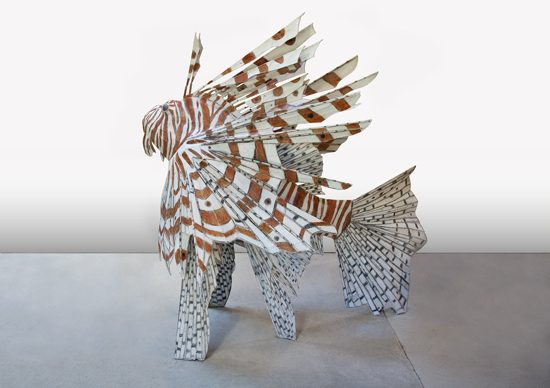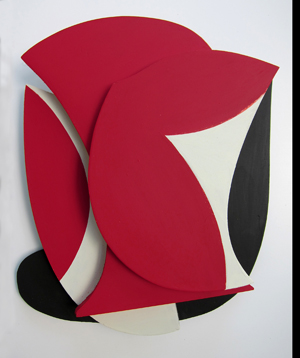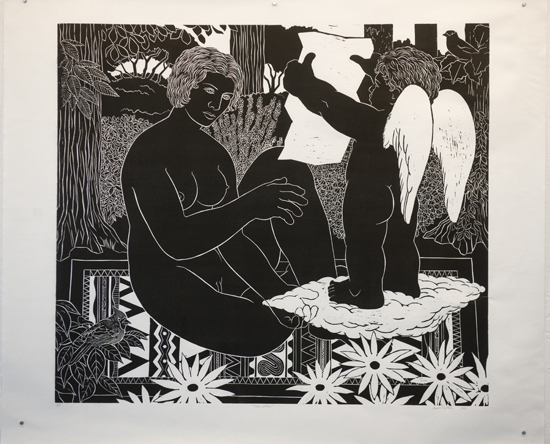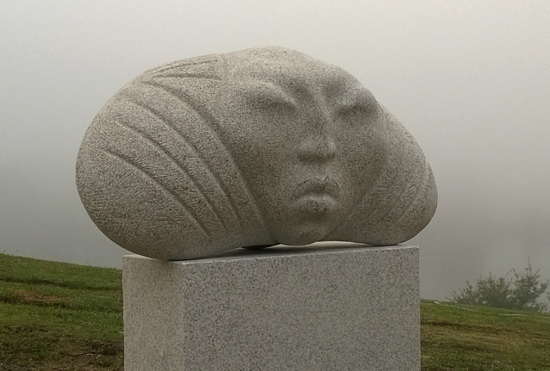Learning from the Masters
Act now, 808 Gallery faculty art exhibition closes Sunday

Lionfish (2014), steel, paper, mixed media sculpture by Kitty Wales, one of more than 30 artists whose work is included in the School of Visual Arts Faculty Exhibition on view at the 808 Gallery. Photo by Kathryn Osgood
People walking past the 808 Gallery on Commonwealth Avenue can be forgiven for doing a double take. Visible through the plateglass windows are two giant sculptures of lionfish, their sheer size and vibrant colors serving as a calling card for the show inside—the School of Visual Arts Faculty Exhibition, which ends this Sunday.
Featuring the work of more than 30 artists who teach painting, sculpture, graphic design, art education, printmaking, and photography, the show underscores the diverse talent among the College of Fine Arts school’s faculty. It also offers a dazzling assemblage of small- and large-scale work, both realism and abstraction, encompassing a wide selection of genres and media.
The two lionfish are the work of Kitty Wales, a CFA lecturer in sculpture. Constructed of steel, paper, and mixed media, the sculptures are part of a commission from the Lyman Allyn Art Museum in New London, Conn., to establish a collaboration with the nearby Mystic Aquarium. Wales’ challenge was to find an acquatic species in the aquarium that would tie into something in the museum’s collection. In observing both institutions’ holdings, she was drawn to the Lyman Allyn’s wonderful folk art collection of 17th-century wooden clipper ships. Studying and drawing from the numerous species at the aquarium, she says, she was particularly struck by how the lionfish reminded her of underwater sailing vessels. “They both had a similar majestic elegance,” Wales says, hence the inspiration for her monumental sculptures.

It took her two years to complete the project. The sculptures had to be lightweight and able to stand on their own, without being suspended from above, while retaining fluid gestures. She found a way to elevate them using their pectoral fins and tails. Wales became enamored of lionfish as she worked on the project. “They’re beautiful fish, challenging, and interesting,” she says, adding that they’re also incredibly invasive. “Nothing eats them because the top of their dorsals are filled with a deadly venom. They’ll eat virtually anything they can fit in their mouths.” Although in reality lionfish are only about 12 inches long, Wales wanted to emphasize their invasiveness by making hers gigantic. The large-scale size also allows them to be interactive with viewers, like giant puppets on a stage set.
The show includes a series of five acrylic on wood paintings by Hugh O’Donnell, a CFA professor of painting. The first four, titled Coda I, Coda II, Coda III, and Coda IV, emphasize the interplay between music and art. “They end a series of paintings that take their inspiration from growth structures in nature,” says O’Donnell. “Branching seedpods and budding forms were abstracted to a point where they had a lot of similarities to musical notation. The whole periodic patterning found in nature is for me a kind of melody, and only through abstraction can I be free to play with this.”
Each work is rendered in the same palette. “The color is conserved to three equal dominant hues of red, black, and white to allow for a constant ambiguity of which one is dominant,” says O’Donnell. “This allows a perceptual tug on the senses.” The fifth piece, in the center, titled Sentinel, bears a slightly darker shade of red, and O’Donnell sees it as a kind of key signature to the group. He says that none of the works was designed beforehand, but rather came “directly out of spontaneous drawing through wood using a jigsaw.”

“I kind of like to see them like a quintet, jamming together,” the artist says.
There are some striking photographs in the exhibition. Greer Muldowney, a CFA lecturer, has two works; one, Cheung Sha Wan, was part of a series of architectural photos she took in Hong Kong. “I was engrossed in learning about housing policy and architecture in Hong Kong and how it had both stayed the same and changed since the British lease ended in the late 1990s,” says Muldowney. This particular view of Cheung Sha Wan on the Kowloon peninsula struck her as “an amazing visual record of how architecture had changed in Hong Kong, growing from older buildings in the immediate, cut-off foreground, to the modern skyscrapers that are being erected at present.” She first became interested in Hong Kong while in graduate school, when she took a group of students there to work on a photography book about the Sham Shui Po district, “one of the last bastions of Hong Kong that is not being radically transformed into the modern city we think of.”

It’s nearly impossible to single out specific artists among the show’s many arresting works, but the viewer can’t help but be mesmerized by Richard Ryan’s woodcut print Bird in Dead Tree. The CFA associate professor of painting says he begins his prints by making a full-scale drawing. He then takes a large piece of birch plywood, paints it black, grids it up with a white pencil, traces the drawing and transfers it in white to the block, where he uses an electric chisel to cut the marks. Each woodblock takes him about two years to complete. Ryan says he began doing woodcuts about seven years ago, after a friend bet him that he couldn’t do one and offered him money to print it if he pulled it off. He says the landscape around his home on the Connecticut River is the inspiration for much of his work. “I walk around a lot and look at what is living here.”
Equally dazzling are two woodblock prints on paper by Aaron Norfolk, a lecturer in painting at CFA. In one, called The Letter, a putto holds up a letter that is being read by a seated female figure. “It’s about the commerce of language between lovers, the private and mysterious dialogue of intimate communication,” he says. “The letter held by the putto is to indicate the intangible weight carried by words, as if by some ethereal transmission.” The scene is reminiscent of Renaissance paintings depicting the Annunciation, where an angel appears to the Blessed Virgin to tell her she will bear a son, Jesus, the son of God. “I am interested in the viewer making such connections,” says Norfolk. “In The Letter, it makes perfect sense and helps bring a spiritual, or divine, element to the piece.”

A painter by training, he says he tried to talk his way out of doing his first woodblock print. “You have to be organized and know what you want when you start to carve,” he says. “There’s not a lot of forgiveness. It’s also not as open or free as some other printing methods.”
Also of note in the show are a pair of paintings by Gideon Bok, a CFA assistant professor of painting, depicting his studios, at 855 Comm Ave and in Maine. Both canvases are described as works in progress. “I work on my paintings for a long time, so it’s kind of like I keep looking at and working from the studio until something interesting happens with the painting,” Bok says. His minutely observed paintings have an almost spectral quality. When friends drop by to visit, he paints them into the scene, then often paints them out. “Most often I just scrape them out or paint the chair over them when they leave, but sometimes I let parts of them hang around in the painting. Unfortunately, this means that they get slowly and agonizingly erased.”
Visitors should be sure to take in Batu Siharulidze’s series of small sculptures, prototypes, called maquettes, for a number of large-scale works he’s executed for various international competitions. Those bigger sculptures are on permanent display in cities around the world. Siharulidze, a CFA associate professor of sculpture, says he competes in two or three such events a year, working in a range of media, such as marble, bronze, wood, and granite (his current favorite, because “it has the most energy locked inside of it”). In the 808 exhibition, Siharulidze’s prototypes appear alongside photos of the large-scale sculptures in their natural settings. Where does he find inspiration for his work? “It comes from everywhere,” the sculptor says. “Nature, humanity, the cosmos. My life experience gives me plenty of material to work with.”

Lynne Allen, School of Visual Arts director, says she hopes students will catch the faculty exhibition before it closes on Sunday. “It’s always inspirational for students to see the work of their professors, and to make connections between what they teach and what they do professionally,” says Allen, who also has work in the exhibition. “The work spans traditional themes, installation, digital, and found objects, offering a glimpse of varied ways of thinking and expressing ideas in today’s contemporary art world.”
The School of Visual Arts Faculty Exhibition is on view at the 808 Gallery, 808 Commonwealth Ave., through Sunday, March 1; hours: Tuesday, Wednesday, and Friday, 11 a.m. to 5 p.m.; Thursday, 11 a.m. to 8 p.m.; and Saturday and Sunday, 1 to 5 p.m. The gallery is closed on Monday. The exhibition is free and open to the public. Take an MBTA Green Line B trolley to the BU West stop.
Comments & Discussion
Boston University moderates comments to facilitate an informed, substantive, civil conversation. Abusive, profane, self-promotional, misleading, incoherent or off-topic comments will be rejected. Moderators are staffed during regular business hours (EST) and can only accept comments written in English. Statistics or facts must include a citation or a link to the citation.